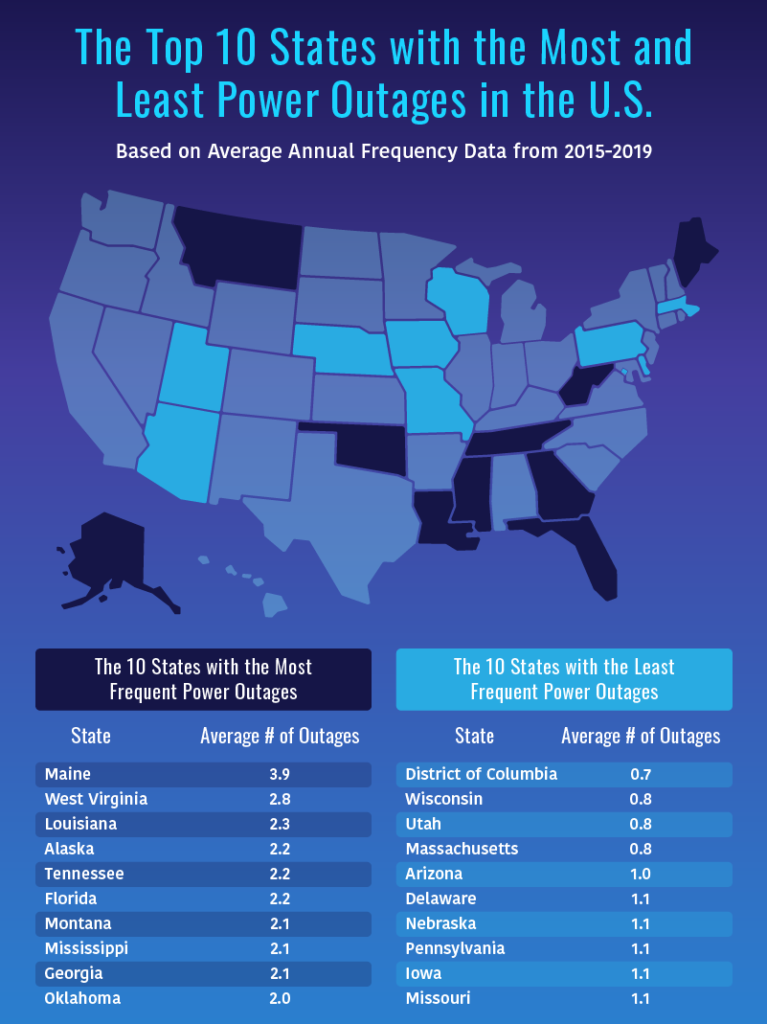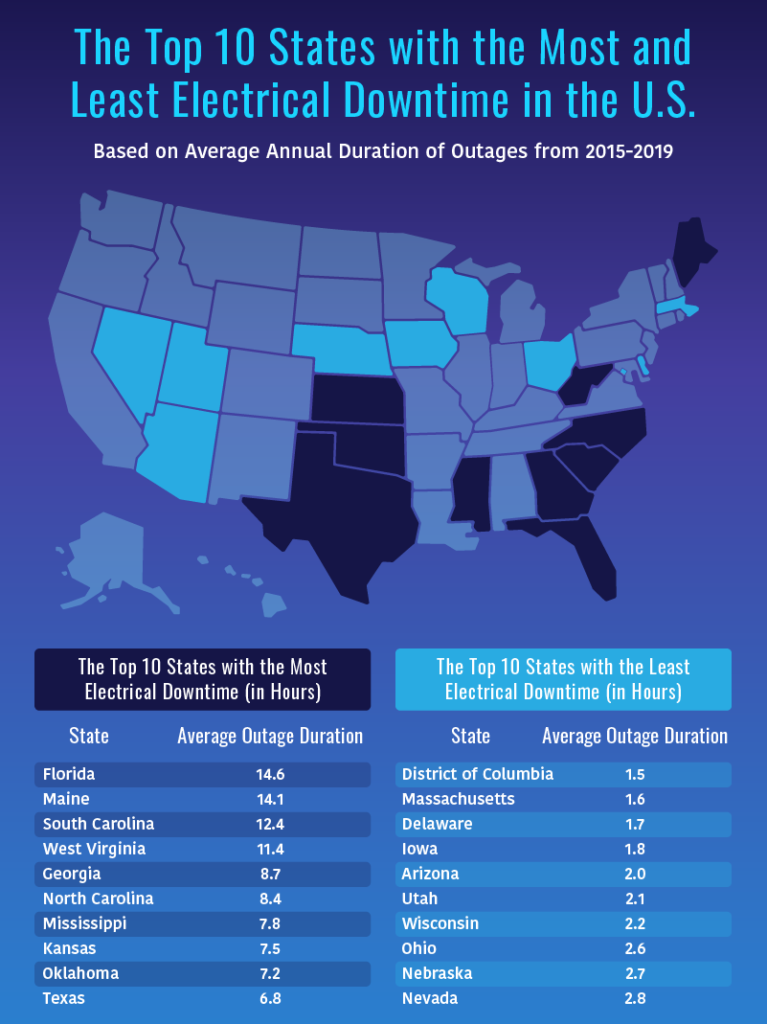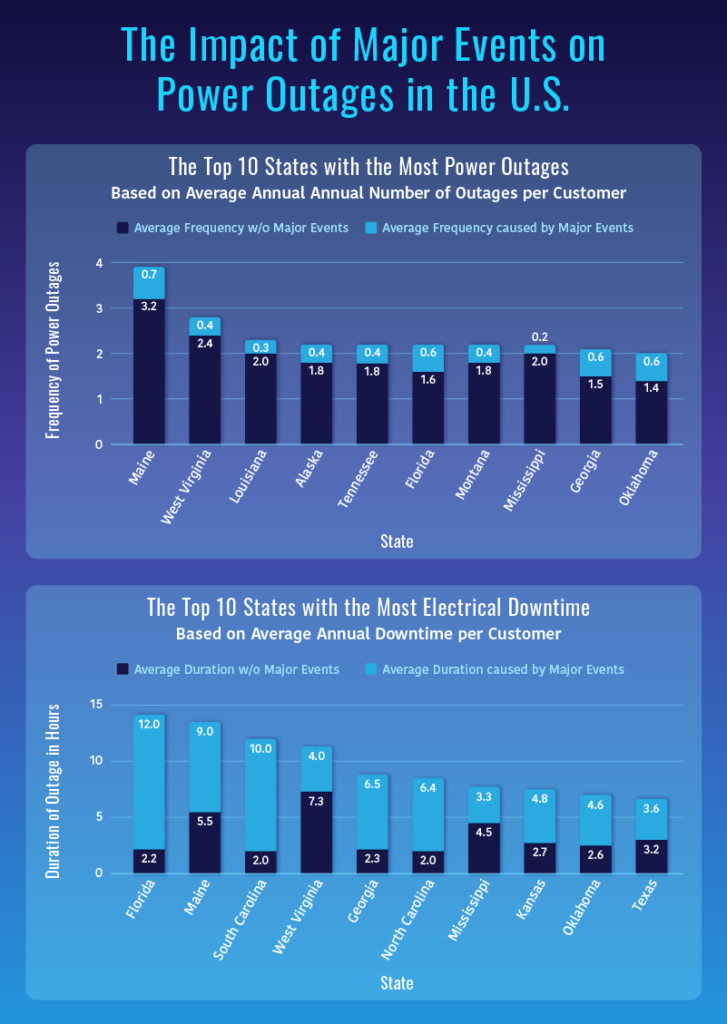
These days, manufacturing is inextricably linked to the power grid. Many manufacturing processes are now automated using increasingly complex software programs and robotic machines that rely on a constant supply of electricity. So when a blackout occurs, more than just the lights go out in a typical factory. Outages can amount to critical failure and gobs of lost revenue for all stakeholders involved.
At MRO Electric, we wanted to find out which U.S. states experience the most and least power outages and electrical downtime. To accomplish that, we collected and analyzed the latest electrical reliability data from the U.S. Energy Information Administration. Specifically, we pulled the average annual frequency and duration of power outages per customer for each U.S. state from 2015 through 2019. Read on to see what we found.
The U.S. States with the Most and Least Power Outages

Which State Has the Most Power Outages?
Maine saw the highest average number of power outages at nearly four per year. This is significantly higher than the runner up, West Virginia, which experienced an average of 2.8 outages per year. Within the other eight states with the most outages, customers could expect an average of around 2 blackouts each year.
Which State Has the Least Power Outages?
On the opposite end of the spectrum, the District of Columbia suffered the fewest outages at an average of 0.7 per year. Wisconsin, Utah, and Massachusetts averaged 0.8 outages annually, Arizona had an average of one per year, and the other five states on the list all tied for an annual average of 1.1 outages.
But the number of power outages only tells half of the story. For a comprehensive picture of electrical reliability, we also looked into the average duration of outages in every state.
The U.S. States with the Most and Least Electrical Downtime

Which State Has the Most Electrical Downtime?
Interestingly, Maine not only experienced the highest average number of outages per year but also held the second most average annual downtime in the country. According to our calculations, downtime in Maine averaged 14.1 hours, beaten only by Florida’s 14.6 hours. Mississippi and Oklahoma show up on both lists as well, making them poor overall contenders for electrical reliability.
Which State Has the Least Electrical Downtime?
On the flip side, the District of Columbia receives top marks yet again with just an hour and a half of downtime on average—while still a significant number in the manufacturing world, it only represents 10% of the agonizing downtime experienced by factories that are affected by the average Floridian blackout.
Use the interactive map below to view the full data set for every U.S. state.
Impact of Major Event Days on Electrical Reliability

Major event days are defined as any day where outage metrics exceed normal averages. While these can sometimes be attributed to hackers, cyber attacks, and other anomalies, they are usually caused by severe weather patterns like hurricanes and blizzards.
However, these troublesome outliers are fairly rare and don’t do much to increase the average number of outages by state. In Maine, consistently ahead of the pack in terms of number and duration of outages, major events only cause 0.7 additional outages per year on average. That brings Maine’s overall average to 3.9 outages per year.
The same can’t be said for duration, though. Surprisingly, major event days cause a whopping 9 hours of additional average downtime in Maine each year. The resulting 14.5 hours is over 150% more than the 5.5 hours of downtime recorded when major events are not considered.
Considering the ten states with the most downtime overall, major events are culpable for as little as 3.6 hours and as much as 12 hours of average annual downtime. In Florida, the average downtime including major events is more than 580% longer than when major events are excluded. Needless to say, when major event days occur, they make a huge difference in terms of how long it takes to get the power back on.
What Normally Causes Power Outages in the United States?
There are a few causes behind power outages in the U.S. Typically, you might notice the power go out during a severe thunderstorm, but even then, the outage typically will not last long.
Other causes of power outages include natural disasters like tornadoes and hurricanes. Snow can also weigh down power lines and cause an extended outage. During periods when there is an elevated risk of wildfires, some states may institute scheduled blackouts to protect the power grid from damage.
What Appliances Still Work During a Power Outage in the U.S.?
During a power outage, appliances that are plugged into an outlet (that do not have a battery backup) will not work. For example, refrigerators, electric stoves, washers, and dryers typically will not work. During a power outage, be sure to keep your refrigerator closed to keep the cool air trapped inside, as it will not be able to produce cold air without a power source.
In situations where maintaining a stable connection is essential, emergency generators that run on gas can keep the lights on. Generators come in numerous sizes and wattages to fit a variety of needs. When using a gasoline generator, be sure to closely follow any safety guidelines and instructions to ensure they do damage any property or trigger issues like carbon monoxide poisoning.
What Should You Do During or Before a United States Power Outage?
During a prolonged power outage, it is essential to keep a few guidelines in mind to ensure your safety and preserve valuable resources. First, keeping your freezers and refrigerators closed is vital to retain the cold temperature and maintain the freshness of perishable items like dairy and meat. If available, use a generator to provide a temporary power supply; however, always operate it outdoors and away from windows to avoid carbon monoxide poisoning.
Refrain from using a gas stove or oven as a heating source for your home during a power outage. Gas stoves and ovens are inefficient at warming your living space and pose a significant fire hazard. Be sure to disconnect appliances and electronics during power outages to prevent them from being damaged when the power comes back.
For those with medical requirements that rely on electricity, it is crucial to have alternate plans in place. These plans could include refrigeration options for medicines or having power-dependent medical devices connected to backup power sources. We also advise checking in with local officials about designated heating and cooling locations open nearby, especially during extreme weather conditions, to find safe spaces that can provide relief from extreme temperatures.
Conclusion
The automation of manufacturing tasks has untold benefits in efficiency and output. The automotive industry, for instance, makes use of robotics for many tasks including welding, painting, and even hauling heavy parts to build more cars in less time. And yet, relying on these impressive technologies means that when you don’t have electricity, you don’t have production.
You may not be able to up and move your factories to one of the states with the least power outages, but you can always rely on MRO Electric to provide a vast array of quality remanufactured and new parts, along with quality repairs to your automation machinery. With MRO Electric, when the power comes back on, you’ll be ready for business.
Updated on July 19, 2023 by Leanna Cota
These are the result of power utilities being managed by lawyers , financial officers and other executives having not a slightest knowledge what electrical (power) engineering is.
It is also the result of poor education on electrical (power) engineering in US colleges and universities which translates to having graduates inept in electrical (power) engineering.
We shall add to this also very law interest among the young to study engineering.
Thanks for the good article of this information. Interesting to see how this will prevail in the year of 2021-2022 . Weather related, Human related. Here in NC the power poles seem to have a lot of collisions from a lot of vehicle’s. Just keep the listing all that happens to the power grid.
In MS more than half the power consumed is thru Coops. Most all the rest is by IOUs: Entergy & Mississippi Power. Can you break your numbers down to match these entities?
Could you provide the data behind your interactive map in a table format? Thanks in advance.
Could you give me more info the state of Alaska and anchorage
It is impossible to to bring forth all the ills in a few paragraphs the United States had buried itself with in the areas of engineering particularly in electrical (power) engineering. Starting with general education in public schools, engineering curriculum in colleges and universities, inept and useless methods and procedure in licensing for engineering practice, job search and employment for engineering professionals, labor laws for engineers, and so forth – all utterly destructive for everything the profession of engineering is called upon to be deal with. We have been eye witnessing, have experienced and endured all the imaginative man-made nightmare engineering professionals are called upon to deal with in real life.
The “major event” definition here is kind of odd. The way these statistics are designed, it makes a state’s statistics look worse if they handle significant weather events better, but not classifying them as a “major event.” A tornado hit about half a mile down my road a few years ago. The power was off at my house for about 3 seconds, so, by the definition used here, this outage was not caused by a “major event,” despite being an actual tornado on my road.